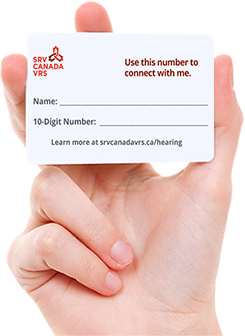Hearing Community
What is Canada VRS?
Canada VRS is a telecommunication service that allows Deaf, hard of hearing or speech-impaired Canadians to make telephone calls using internet and cell phone-based technologies. VRS callers are connected with a sign language interpreter who provides real time interpretation for telephone calls.
To register for a Canada VRS account, you must be a Deaf, hard of hearing or speech-impaired Canadian who uses sign language.
Who uses Canada VRS?
Many Canadians use Canada VRS every day. Whether it’s a doctor seeking advice from a colleague, a parent delivering news of their new baby to a grandparent or a business owner discussing finances with their accountant, Canada VRS is increasing access and opening opportunities for us all.
How does Canada VRS work?
Deaf, hard of hearing or speech-impaired Canadians who use sign language can download and register for a free Canada VRS app for iOS, Android, Windows, and Mac computers.
Once registered they are given a VRS number which they use to make and receive calls. The app connects Canada VRS users to a sign language interpreter who relays the call in real time, in ASL and LSQ.
If you receive a VRS call, remember, “Don’t Hang Up!”
When you receive a VRS call the first thing you’ll hear is a VI letting you know that a caller who uses sign language is calling you. Remember, “Don’t Hang Up”. Sometimes there is a short delay while the VI connects you with your caller so please stay on the line.
This is what it sounds like when you receive a call from someone using Canada VRS.
Still have questions about Canada VRS?
FAQs
WHAT LANGUAGES DOES CANADA VRS SUPPORT?
DO I NEED TO HAVE THE CANADA VRS APP TO RECEIVE OR PLACE A CALL?
IS THERE A COST TO USING CANADA VRS?

What are ASL and LSQ?
ASL and LSQ are sign languages. ASL stands for ‘American Sign Language’ and is primarily used by English Deaf or hard of hearing Canadians. LSQ stands for ‘Langue des signes Québécoise’ and is used primarily by French Deaf or hard of hearing Canadians.
ASL originated in the American School for the Deaf in Hartford, Connecticut, USA in the early 19th century. Since then, ASL use has expanded in the US and Canada primarily via schools for the Deaf and Deaf community organizations.
LSQ was first developed in Quebec in 1850 as a mixture of French Sign Language (LSF) and American Sign Language (ASL). LSQ is used primarily in Quebec but also in francophone communities across Canada.
ASL and LSQ have their own unique rules of grammar and syntax and as is the case with most spoken languages, individual countries have their own sign languages and dialects that evolve over time.
If you work in a bank, healthcare facility or government office, you may require a personal information consent form.
Many offices require consent or permission to disclose personal information over the phone when a “3rd party” or as in this case, a VRS interpreter (VI) is part of the VRS call. Canada VRS has prepared a form to assist VRS user to give their permission in these situations.

